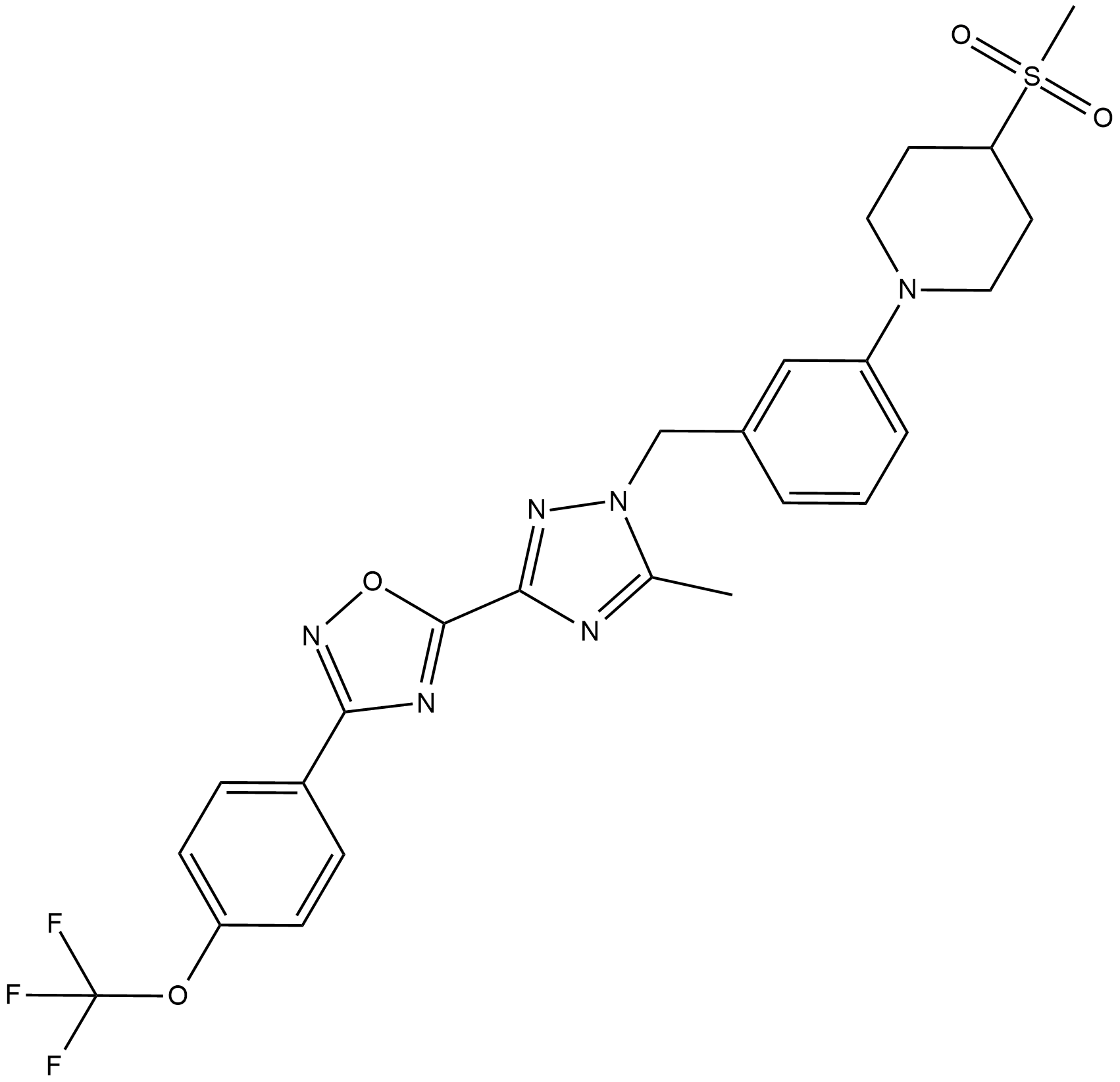IACS-10759 |
| Catalog No.GC19194 |
IACS-10759 (IACS-010759) is an oxidative phosphorylation inhibitor, IACS-10759 is a potent inhibitor of complex I of oxidative phosphorylation ( OXPHOS )
Products are for research use only. Not for human use. We do not sell to patients.

Cas No.: 1570496-34-2
Sample solution is provided at 25 µL, 10mM.
IACS-10759 (IACS-010759) is an oxidative phosphorylation inhibitor, IACS-10759 is a potent inhibitor of complex I of oxidative phosphorylation ( OXPHOS )[1].
IACS-010759 targets glycolysis-deficient tumor cells, In most cell lines, IACS-010759 treatment modestly increased apoptosis by up to twofold[1]. IACS-010759, like known quinone-site inhibitors, suppresses chemical modification by the tosyl reagent AL1 of Asp160 in the 49-kDa subunit, located deep in the interior of a previously proposed quinone-access channel[2]. IACS-010759 in complex I is the membrane-embedded ND1 subunit because amino acid substitution at Leu55 (to Phe) in this subunit, which faces the proposed ubiquinone-access channel interior[3].Treatment of primary CLL cells with IACS-010759 greatly inhibited OxPhos but caused only minor cell death at 24 and 48 h. In the presence of stroma, the drug successfully inhibited OxPhos and diminished intracellular ribonucleotide pools[4]. Inhibition of OxPhos(by IACS-010759) induced transfer of mitochondria derived from mesenchymal stem cells (MSCs) to AML cells via tunneling nanotubes under direct-contact coculture conditions. Inhibition of OxPhos also induced mitochondrial fission and increased functional mitochondria and mitophagy in AML cells[5]. Systems analysis of IACS-010759-induced changes in RTS osteoblasts revealed that chemical inhibition of mitochondrial respiratory complex I impaired cell proliferation, induced senescence, and decreased MAPK signaling and cell cycle associated genes, but increased H19 and ribosomal protein genes[8]. In vitro, the combination of AZD3965 and IACS-010759 is synergistic and induces DLBCL cell death, whereas monotherapy treatments induce a cytostatic response[9].
IACS-010759 also suppressed tumor growth in zebrafish and mouse xenograft models of high-risk neuroblastoma[6].Changes in blood glucose level with single or repeated doses of IACS-010759 did not observe. However, at 2 h after the first or fifth dose, plasma insulin levels transiently decreased and returned to control levels by 24 h postdose[1]. IACS-010759 as an OXPHOS inhibitor currently in early-phase clinical trials, improved survival of mice bearing MAPK inhibitor-resistant intracranial melanoma xenografts and inhibited melanoma brain metastases (MBM) formation in the spontaneous MBM model[7].
References:
[1]. Molina JR, Sun Y, et,al. An inhibitor of oxidative phosphorylation exploits cancer vulnerability. Nat Med. 2018 Jul;24(7):1036-1046. doi: 10.1038/s41591-018-0052-4. Epub 2018 Jun 11. PMID: 29892070.
[2]. Tsuji A, Akao T, et,al.IACS-010759, a potent inhibitor of glycolysis-deficient hypoxic tumor cells, inhibits mitochondrial respiratory complex I through a unique mechanism. J Biol Chem. 2020 May 22;295(21):7481-7491. doi: 10.1074/jbc.RA120.013366. Epub 2020 Apr 14. PMID: 32295842; PMCID: PMC7247293.
[3]. Zhu J, Vinothkumar KR, et,al. Structure of mammalian respiratory complex I. Nature. 2016 Aug 18;536(7616):354-358. doi: 10.1038/nature19095. Epub 2016 Aug 10. PMID: 27509854; PMCID: PMC5027920.
[4]. Vangapandu HV, Alston B, et,al.Biological and metabolic effects of IACS-010759, an OxPhos inhibitor, on chronic lymphocytic leukemia cells. Oncotarget. 2018 May 18;9(38):24980-24991. doi: 10.18632/oncotarget.25166. PMID: 29861847; PMCID: PMC5982765.
[5]. Saito K, Zhang Q, et,al.Exogenous mitochondrial transfer and endogenous mitochondrial fission facilitate AML resistance to OxPhos inhibition. Blood Adv. 2021 Oct 26;5(20):4233-4255. doi: 10.1182/bloodadvances.2020003661. PMID: 34507353; PMCID: PMC8945617.
[6]. Anderson NM, Qin X, et,al. Metabolic Enzyme DLST Promotes Tumor Aggression and Reveals a Vulnerability to OXPHOS Inhibition in High-Risk Neuroblastoma. Cancer Res. 2021 Sep 1;81(17):4417-4430. doi: 10.1158/0008-5472.CAN-20-2153. Epub 2021 Jul 7. PMID: 34233924; PMCID: PMC8577318.
[7]. Fischer GM, Jalali A, et,al. Molecular Profiling Reveals Unique Immune and Metabolic Features of Melanoma Brain Metastases. Cancer Discov. 2019 May;9(5):628-645. doi: 10.1158/2159-8290.CD-18-1489. Epub 2019 Feb 20. PMID: 30787016; PMCID: PMC6497554.
[8]. Jewell BE, Xu A, et,al.Patient-derived iPSCs link elevated mitochondrial respiratory complex I function to osteosarcoma in Rothmund-Thomson syndrome. PLoS Genet. 2021 Dec 29;17(12):e1009971. doi: 10.1371/journal.pgen.1009971. PMID: 34965247; PMCID: PMC8716051.
[9]. Noble RA, Thomas H, et,al.Simultaneous targeting of glycolysis and oxidative phosphorylation as a therapeutic strategy to treat diffuse large B-cell lymphoma. Br J Cancer. 2022 Sep;127(5):937-947. doi: 10.1038/s41416-022-01848-w. Epub 2022 May 26. PMID: 35618788; PMCID: PMC9428179.
Average Rating: 5 (Based on Reviews and 20 reference(s) in Google Scholar.)
GLPBIO products are for RESEARCH USE ONLY. Please make sure your review or question is research based.
Required fields are marked with *




















